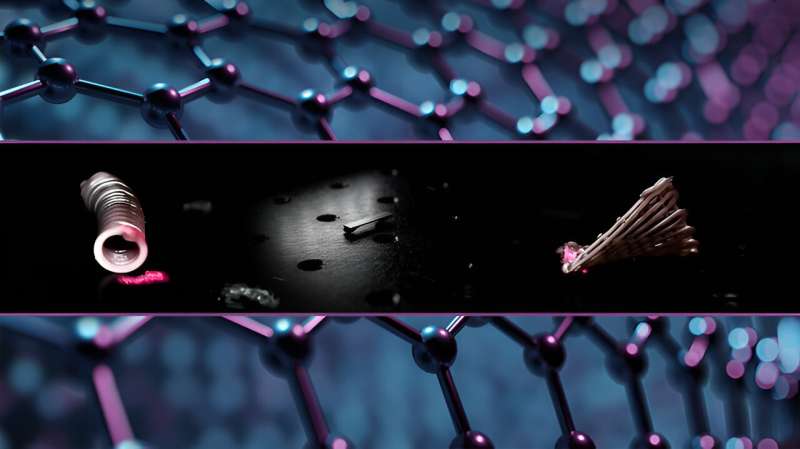
Researchers at Lawrence Livermore National Laboratory have furthered a new type of soft material that can change shape in response to light, a discovery that could advance "soft machines" for a variety of fields, from robotics to medicine.
The novel material called a liquid crystal elastomer (LCE), is made by incorporating liquid crystals into the molecular structure of a stretchable material. Adding gold nanorods to the LCE material, scientists and engineers created photo-responsive inks and 3D-printed structures that could be made to bend, crawl, and move when exposed to a laser that causes localized heating in the material.
As described in their paper published in the journal Matter, the LLNL team, along with their collaborators from Harvard University, North Carolina State University, and the University of Pennsylvania, used a direct ink writing printing technique to build a variety of light-responsive objects, including cylinders that could roll, asymmetric "crawlers" that could go forward and lattice structures that oscillated. By combining shape morphing with photoresponsivity, researchers said the new type of material could change the way people think about machines and materials.
"At LLNL, we've focused on developing static materials and architectures for some time," said principal investigator Caitlyn Krikorian (Cook).
"We've made these complex types of structures like hierarchical lattices, and we've even started exploring more responsive materials, like shape memory polymers, that have a one-time shape memory response. But the Lab really hadn't delved deep into creating architectures that can go from a 3D-to-3D type of shape change. This project is starting to show how architecture and these novel materials can have unique modes of actuation that we haven't researched before."
Researchers said the new material could be used to create a "soft machine"—a type of machine made from these flexible LCE composite materials—capable of responding to external stimuli and even mimicking the movements and behaviors of living organisms.
Soft robots made of shape-morphing material could crawl, swim, or fly and explore environments that are too difficult or dangerous for humans to access, like caves or outer space. Soft machines could also be used in medical applications, such as implantable devices that can adapt to the body's movements, or prosthetic limbs that move like natural limbs, and other applications that aren't possible with machines made from rigid materials, like metal or plastic.
"Rigid robots maybe wouldn't be ideal for humans to interact with, so we need systems and materials that are more compliant," said the paper's lead author, Michael Ford, who began working on responsive materials while a postdoc at Carnegie Mellon University.
"You start with components that make up our robots, and one of those components is an actuator. That's where these materials come in; they could potentially be an actuator. It reduces computational complexity; you're making a material that gets rid of onboard electronics and replacing them with a single material that can do all those things. That will allow you to put more computational complexity into another component or drive power to other sensors that you wouldn't have been able to do with traditional rigid materials."
More information: Michael J. Ford et al, Movement with light: Photoresponsive shape morphing of printed liquid crystal elastomers, Matter (2024). DOI: 10.1016/j.matt.2024.01.006
Citation: Are shape-shifting 'soft machines' in our future? Scientists advance light-responsive material (2024, February 12) retrieved 12 February 2024 from https://techxplore.com/news/2024-02-shifting-soft-machines-future-scientists.html
This document is subject to copyright. Apart from any fair dealing for the purpose of private study or research, no part may be reproduced without the written permission. The content is provided for information purposes only.
